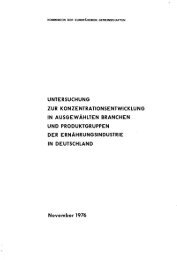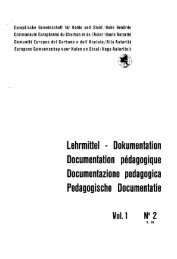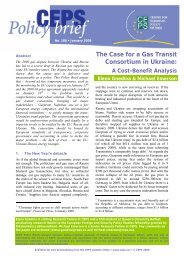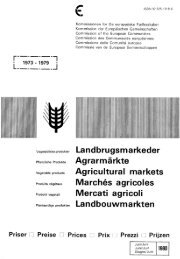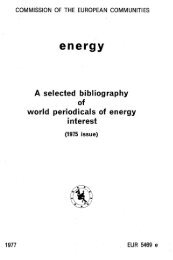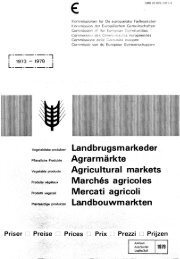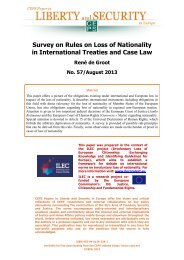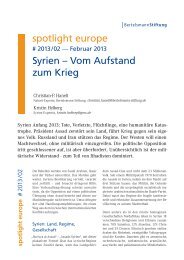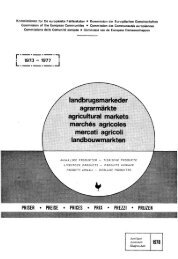Download (1447Kb) - Archive of European Integration
Download (1447Kb) - Archive of European Integration
Download (1447Kb) - Archive of European Integration
Create successful ePaper yourself
Turn your PDF publications into a flip-book with our unique Google optimized e-Paper software.
' . 1<br />
.<br />
. ~ :-- .<br />
"""7 """"' '7<br />
'""""' .............<br />
('ar <strong>of</strong> To1norrow<br />
* ti<br />
uui:?<br />
EUROPEAN COMMISSION<br />
Task Force "Car <strong>of</strong> Tomorrow"<br />
Car <strong>of</strong><br />
Tomorrow<br />
I<br />
-<br />
-f.···-.:_<br />
~·,. -.1 •<br />
· ··~--: Plan<br />
<strong>of</strong> Action<br />
-- - ><<br />
Uj<br />
UJ<br />
(.)
c, .;; t: , o 2 J 6 ':.> ,~ • i./ r lJ lf l3, 3 tJ 1.1 7~ z 62.<br />
/ST,' 732~<br />
EUROPEAN COMMISSION<br />
CAR OF TOMORROW<br />
ACTION PLAN<br />
Contact points:<br />
E. Andreta, Director Task Force Car <strong>of</strong> Tomo"ow<br />
Director DGXII/F - ROT Actions : Energy<br />
Tel. +3212/295.16.60 - Fax : +32/2/299.18.47<br />
D. Miles, Deputy to Director Task Force Car <strong>of</strong> Tomo"ow<br />
Head <strong>of</strong> Unit DGXII/F-2<br />
Tel. +32121296.20.19 - Fax : +3212/299.18.47<br />
Address:<br />
EUROPEAN COMMISSION<br />
DGXII/F<br />
Rue Montoyer 75<br />
8-1 U40 Brussels<br />
22 December 1995
TABLE OF CONTENTS<br />
Foreword 1<br />
1. Rationale 1<br />
2. Need for Action at <strong>European</strong> Level 3<br />
3. Car <strong>of</strong> Tomorrow Action Plan Objectives 4<br />
3.1 Short to Medium Term 4<br />
3.2 Long Term 4<br />
4. Overview <strong>of</strong> Scientific and Technological Content 5<br />
5. Resources needed 9<br />
5.1 Timing 9<br />
5.2 Linking Technology and Policy through a<br />
continuing dialogue within the Commission<br />
and with external bodies 10<br />
6. Conclusion 10<br />
7. Proposed Actions 11<br />
ANNEXES<br />
1. Terms <strong>of</strong> Reference<br />
2. Commentary on Justification for Action<br />
at the <strong>European</strong> level<br />
Ill<br />
2. List <strong>of</strong> Participants, Strasbourg 14 June 1995. X
FOREWORD<br />
Established at the initiative <strong>of</strong> Commissioners Edith Cresson, Martin Bangemann and Neil<br />
Kinnock the Research-Industry Task Force Car <strong>of</strong> Tomorrow began its work in May 1995.<br />
The Terms <strong>of</strong> Reference require :<br />
the preparation <strong>of</strong> an inventory <strong>of</strong> the current situation in the <strong>European</strong> Union<br />
identifying current actions - whether at the public, private, national or Community<br />
level - in this area;<br />
*<br />
the definition <strong>of</strong> the research priorities and technological objectives while at the<br />
same time proposing a regrouping <strong>of</strong> projects selected in the framework <strong>of</strong> specific<br />
programmes which make up the Fourth RDT Framework Programme.<br />
The problems resulting from increasing road traffic have a growing effect on our daily life<br />
and threaten the quality <strong>of</strong> life <strong>of</strong> us all. The provision <strong>of</strong> clean, safe, intelligent vehicles<br />
with an adequate performance is a legitimate demand <strong>of</strong> the <strong>European</strong> citizens. For the<br />
industry to respond with a vehicle competitive in price is a tremendous technological<br />
challenge, as well as an essential condition to maintain or rather reinforce its future<br />
competitivity.<br />
This Action Plan results from the terms <strong>of</strong> reference for the Task Force (see Annex 1) and<br />
consultations with representatives <strong>of</strong> public and private organisations concerned with the<br />
use and production <strong>of</strong> vehicles (see Annex 3), together with a series <strong>of</strong> investigations<br />
conducted by the Task Force. The text was finalised following a meeting with all interested<br />
parties which took place in Brussels on 30 October 1995.<br />
1
1 . Rationale<br />
There is mounting public concern over the growth trends in road transport and the<br />
harmful externalities it generates. Increasing traffic congestion and unrestricted<br />
consumption <strong>of</strong> finite reserves <strong>of</strong> fossil fuels are unsustainable in the long term. Human<br />
health and safety are at risk from harmful emissions and road traffic accidents. In order<br />
to maintain a functionally effective transport system in the short to medium term, urgent<br />
solutions are required to alleviate urban transport pollution and congestion, where<br />
population exposure is greatest. The complexity <strong>of</strong> the transport system and the huge<br />
investments and long time constants to achieve significant change are such that a suitably<br />
measured response is required. This must consider the global consequences and likely<br />
acceptability <strong>of</strong> alternative technologies.<br />
The challenge is to have industry and public authorities working together to<br />
advance new technological concepts which reflect changing <strong>European</strong> Union policies for<br />
transport, energy and the environment, whilst respecting social needs and contributing to<br />
industral competitivity. There is already a broad consensus on the performance and<br />
environmental targets which define a pathway to the Car <strong>of</strong> Tomorrow.<br />
Recognizing the car's highly valued attributes <strong>of</strong> flexibility, privacy, security,<br />
comfort and amenity, it will evidently continue to be a vital element <strong>of</strong> mature societies.<br />
However it will need to operate with much reduced environmental impact, within a more<br />
integrated and controlled road transport system, fully exploiting telematics technologies<br />
and advanced information systems, ensuring its compatiblity with multimodal transport<br />
systems.<br />
Accordingly the scope <strong>of</strong> the action, with its focus on RTD and demonstration on<br />
propulsion systems will, in addition to cars, also apply to buses, trucks, vans and<br />
motorised two-wheelers and the associated infrastructure for road, telematics, refuelling<br />
and recharging.<br />
The process <strong>of</strong> setting a technological focus should be guided by comprehensive<br />
analysis and periodic review <strong>of</strong> the most promising technological options, set against<br />
agreed performance, emissions, safety, economic and social criteria. Technical progress<br />
should be continuously monitored to provide necessary inputs to the regulatory and<br />
standards making processes. To ensure a balanced approach to the introduction,<br />
acceptance and use <strong>of</strong> new vehicle concepts, it is necessary to ensure the cooperation <strong>of</strong><br />
public authorities, the vehicle and component industries, other industries involved, and the<br />
providers <strong>of</strong> capital investment.<br />
The Action Plan will be implemented as far as possible within the structure and<br />
constraints <strong>of</strong> the existing Framework Programme (FP4). Specialist working groups will<br />
coordinate and capitalise on synergies between RTD&D efforts at <strong>European</strong>, national and<br />
industrial levels. Opportunities for more focused activities under article 130 k,l,n <strong>of</strong> the<br />
Treaty on <strong>European</strong> Union will also be explored.<br />
2
2. Need for Action at <strong>European</strong> Level<br />
The VVhite Paper on Growth, Competitiveness, and Employment identifies the need<br />
for new approaches to promoting growth in a sustainable way, whilst achieving higher<br />
employment and lower consumption <strong>of</strong> energy and natural resources, and improving the<br />
quality <strong>of</strong> life. This is reinforced in the Commission White Paper "The Future Development<br />
<strong>of</strong> the Common Transport Policy" which identifies major concerns as managing demand<br />
for road transport, reducing its social and environmental impact, alleviating congestion and<br />
improving road safety.<br />
The EU energy policy aims to stabilize greenhouse gas (mainly C0 2 ) emissions at<br />
1990 levels by 2000. Road transport currently accounts for 80% <strong>of</strong> energy consumed by<br />
transport - 30o/o <strong>of</strong> final energy demand in Europe. This is unsustainable in the face <strong>of</strong><br />
dwindling fossil fuel reserves, the persistent threat to global energy security and growing<br />
concerns linking exhaust emissions with cancer and respiratory disease.<br />
Harmful emissions attributed to road transport include lead, carbon-monoxide (CO),<br />
volatile organic compounds (VOC), including hydrocarbons (HC), oxides <strong>of</strong> nitrogen (NOx),<br />
oxides <strong>of</strong> sulphur (SOx), and particulates. The total external costs, in economic terms, <strong>of</strong><br />
health problems attributed to transport emissions are estimated at 0.3-0.4o/o <strong>of</strong> GOP.<br />
Mobility is essential to economic activity and the automotive industry is itself a<br />
major wealth creator. Vehicle production contributes 2% to the <strong>European</strong> GOP; 1 .8 m<br />
employed represents 8.3% <strong>of</strong> all manufacturing jobs. A further 1.8m are employed in<br />
distribution and repair. The industry is critically dependent on its ability to produce world<br />
class products at fiercely competitive prices. It is vital that <strong>European</strong> RTO does not lag<br />
RTO effort in Japan and the US. The US government has been providing 375-450 MECU<br />
per year for automotive related technology in general. That compares with 135MECU per<br />
year in the EU Third Framework Programme (ie. excluding national programmes). In 1991<br />
the "Big Three" US car makers and the government formed the four year, $262m, sharedcost<br />
United States Advanced Battery Consortium battery development project. The US<br />
Partnership for a New Generation Vehicle (PNGV) receives $933m for 1994-1996, and<br />
has three main goals- advanced manufacturing, improved efficiency, safety and emissions,<br />
and the 80mpg (31itres/1 OOkm) car. The Californian Low Emission Vehicle Programme<br />
effectively legislates EV sales from 1998. With five other states already following,<br />
cumulative sales <strong>of</strong> 1 million EVs by 2003 are predicted.<br />
Information on Japanese RTD expenditure is much harder to find. Since 1971 the<br />
MITI has been supporting EV-related RTD. In 1991 NEDO launched the 1 Oyear, 14bY<br />
( = 120MECU) LIBES programme for developing lithium batteries with very high<br />
performance and reliability targets. The Japanese are also pursuing a fuel cell development<br />
programme. The Japanese launched a market expansion programme in 1991 with targets<br />
for cumulative EV sales <strong>of</strong> 200.000 by 2000, and production <strong>of</strong> 100.000 per year,<br />
although these targets are understood to have been relaxed somewhat.<br />
Applied to the Car <strong>of</strong> Tomorrow the issues identified reinforce the need for Europe<br />
to produce world class vehicles which are efficient, clean, and safe and fully integrated<br />
with future transport systems. The negative impacts <strong>of</strong> road transport - environmental<br />
pollution, the risk <strong>of</strong> irreversible global climatic changes, traffic accidents and congestionare<br />
global problems requiring a global response. Atmospheric pollution and greenhouse<br />
3
gas emissions do not respect national frontiers. However these harmful externalities must<br />
be put in balance with the wealth and employment opportunities created by the automotive<br />
and component industries as well as with the need for mobility <strong>of</strong> EU citizens. There is<br />
always substantial financial and technical risk in advancing new technologies- beyond the<br />
resource <strong>of</strong> any single company or country. Common measures should be adopted<br />
throughout the EU to secure a single market for the exploitation <strong>of</strong> appropriate new<br />
technologies.<br />
Accordingly, the Action Plan aims to support development <strong>of</strong> a number <strong>of</strong> propulsion<br />
technology options, against defined targets and timescales for harmful emissions<br />
reduction, energy efficiency and fleet average energy consumption. These options must<br />
be subject to regular review and rigorous comparison, with a view to defining the most<br />
cost-effective and consumer acceptable future development strategy. Emphasis is placed<br />
on stimulating the development <strong>of</strong> inherently clean propulsion technologies for operation<br />
in areas <strong>of</strong> high population density, and which can eventually act as a vector for renewable<br />
energy sources. These include fuel cell, battery electric and hybrid electric vehicles and<br />
emissions reducing technologies for ICEs. The work will be set within a common<br />
perspective for the Car <strong>of</strong> Tomorrow which reflects EU policies for transport, energy,<br />
environment and industry, maximising social benefits and creating opportunities for<br />
employment and training.<br />
For a more extensive analysis <strong>of</strong> the justification for <strong>European</strong> action see Annex 2.<br />
3. Car <strong>of</strong> Tomorrow Action Plan Objectives<br />
The Terms <strong>of</strong> Reference which provide the basis for this Action Plan have as their<br />
objective to contribute to the research and demonstration efforts necessary to realise the<br />
Car <strong>of</strong> Tomorrow which will be clean, safe, energy efficient and "intelligent". Accordingly<br />
the Action Plan has been prepared in close consultation with all the actors concerned<br />
including those from automobile, electronics, materials, and energy related industries and<br />
public authorities. Starting from an assessment <strong>of</strong> the current situation, the essential RTD<br />
needs to achieve the objective have been identified. By mapping these onto current<br />
activities, the additional RTD priorities for <strong>European</strong> action have been established.<br />
Recognising that a flexible approach is essential to leave room for rapidly emerging and<br />
promising technologies identified by industry, the basis for future action is set in terms <strong>of</strong><br />
the following deliverables :<br />
3.1. Short to Medium Term:<br />
- energy efficient, competitive ultra low and near zero emission vehicles (ULEV)<br />
vehicles for both urban and regional use, incorporating ultra-low emission<br />
combustion engines and cleaner fuels;<br />
radically new, competitive, safe, intelligent, energy efficient, zero em1ss1on<br />
vehicle (ZEV) concepts, such as ultra compact electric vehicles (EV) for urban<br />
use;<br />
3.2 Long Term :<br />
radical, fully sustainable, negligible or zero em1ss1on propulsion systems (for<br />
example fuel cells), which have the prospect <strong>of</strong> exploiting renewable primary<br />
4
energy sources;<br />
4. Overview <strong>of</strong> Scientific and Technological Content<br />
The technological emphasis <strong>of</strong> the Action Plan is the radical reduction <strong>of</strong> the<br />
environmental impact <strong>of</strong> the Car <strong>of</strong> Tomorrow, compatible with commercial acceptability<br />
<strong>of</strong> the product. Essentially that means coordination <strong>of</strong> RTD&D effort at Union, member<br />
state, and industrial level on technologies capable <strong>of</strong> yielding substantial improvements in<br />
vehicle concepts and technologies leading to sub-ULEV and ZEV. Although much has been<br />
achieved since the 1966 Californian Clean Air Act (which was an initial stimulus to<br />
<strong>European</strong> effort on emissions reduction), reductions in absolute emissions levels have been<br />
<strong>of</strong>fset by growth in road transport demand and customer demands for higher performance,<br />
more fully equipped vehicles.<br />
Considering RTD&D on propulsion technologies, Otto (gasoline) and Diesel internal<br />
combustion engines (ICEs) set very high standards for performance and cost, as the data<br />
for typical 4-seater <strong>European</strong> small electric and ICE cars in Table 1 show. The Hybrid<br />
Electric Vehicle (HEV) is an opportunity to combine optional zero emission electric traction<br />
with the performance advantage <strong>of</strong> ICEs. Because <strong>of</strong> the ICE's vital role in powering HEVs<br />
some RDT&D effort on integration <strong>of</strong> cleaner, more efficient ICEs in HEV, is foreseen.<br />
There are also spin-<strong>of</strong>f benefits for conventional vehicles.<br />
Table 1: Current Typical <strong>European</strong> Small 4-Seater Car Performance<br />
Propulsion Fuel Range Refuel Acceler. Top Speed Cost<br />
Cons.* (km) time 0-100km/h km/h ECU/kW<br />
litres/100km (min) (s) **<br />
Otto 8.1/5.7 450-700 3-4 15 140-150 200<br />
(petrol)<br />
Otto 8.1/5.7 250-300 3-4 140-150<br />
(CNG)<br />
Diesel 6.1/4.7 650-850 3-4 17 135-145 225<br />
EV - 80-100 480 - 90-100 1000<br />
Conv.***<br />
overall/touring fuel consumption<br />
** Cost based on whole car, including batteries in case <strong>of</strong> EV<br />
*** Electric car "conversion design" - converted from equivalent ICE model.<br />
Alternative propulsion systems (eg. battery, fuel-cell, hybrid) <strong>of</strong>fer the best prospect for<br />
negligible point <strong>of</strong> use and global emissions. However consumers' reasonable expectations<br />
for replacement technologies are that they should be at least as good as ICE vehicles in<br />
terms <strong>of</strong> performance, cost and convenience. Detailed Performance Targets and RTD&D<br />
priorities for technological action at <strong>European</strong> level will be given in a separate document,<br />
reflecting discussions with the actors concerned.<br />
5
4.1 Table 1 clearly demonstrates the relatively poor range, speed, performance, cost<br />
and recharge time for current battery-electric "conversion" designs. Battery cost,<br />
performance, durability and recyclability remain the principle RTD challenge for pure<br />
EVs, with direct spin-<strong>of</strong>f benefits to HEVs. Battery concepts such as lithium<br />
carbon, sodium nickel chloride and metal-air, variously <strong>of</strong>fer real potential to achieve<br />
substantial gains in range {threefold) and performance and, subject to series<br />
production, also cost reductions. Comprehensive fleet demonstration <strong>of</strong> existing<br />
EV technology is envisaged, to prove EV capability {eg winter performance,<br />
reliability, fleet management), customer acceptability, and to obtain energy and<br />
emissions performance comparisons with comparable ICE vehicles<br />
Key technological barriers for Battery-Electric Vehicle development:<br />
- high specific energy, rapidly rechargeable batteries with long cycle life,<br />
- /ow-cost functional battery materials and production and recycling processes,<br />
- /ow-cost battery energy management and control systems,<br />
- energy efficient vehicle auxiliary power systems, e.g. heating and air<br />
conditioning,<br />
- low cost peak power devices for battery load levelling.<br />
4.2 Fuel cells generate electrical power by chemical combustion, have no moving parts,<br />
and are silent in themselves, though they normally require air compressors. The<br />
most promising technology is the Solid Polymer Fuel Cell {SPFC) running on H 2 and<br />
air. The SPFC, which emits only water, could be classed as a ZEV over the whole<br />
energy pathway, provided the H 2 is produced from renewable energy sources. Fuel<br />
efficiencies approaching 60% are in principle possible. To avoid the complexity and<br />
expense <strong>of</strong> an H 2 refuelling infrastructure, and the controversial issue <strong>of</strong> H 2 safety,<br />
it is also possible to reform H 2 from methanol or NG on board the vehicle, or oxidise<br />
methanol directly in a special fuel cell. Extended range ( > 500km) operation<br />
depends on the vehicle fuel storage capacity. Refuelling time is comparable to an<br />
ICE vehicle. Fuel cells therefore are potentially the most efficient and cleanest long<br />
term propulsion technology, provided costs and volumetric energy density can be<br />
very substantially reduced.<br />
Key technological barriers for fuel cells:<br />
- low cost membranes and bipolar plates with improved current density and<br />
reduced catalyst loading,<br />
- compact, low cost reformer and gas clean-up systems,<br />
- electronic energy management and control systems,<br />
- lightweight, safe, and energy efficient compressed and liquified gas storage<br />
tanks.<br />
4.3 Various HEV configurations are possible. "Parallel" hybrids generally consist <strong>of</strong> a<br />
conventional ICE drive train which can be "assisted" by a battery powered<br />
motor/generator. This allows down-sizing <strong>of</strong> the ICE, with peak accelerative power<br />
and energy recovery being provided by the motor/generator, as well as optional<br />
zero emission mode operation. The "series" hybrid is primarily battery - electric<br />
propulsion, but with a (usually) small ICE/generator running at its optimum<br />
efficiency, as a range extender. Peak power devices, such as a flywheel or<br />
6
. . '<br />
.... -~ .j "" ' ,"j~ ' t<br />
,' ' ' ;c • ""<br />
supercapacitor may provide additional battery load levelling. Substantial reductions<br />
(20-30°/o) in vehicle energy consumption (and hence emissions) are reported for<br />
hybrids, but the dual technology introduces high cost penalties, and there is a<br />
complex, variable trade-<strong>of</strong>f possible between vehicle and power station emissions.<br />
Key technological barriers for HEV development:<br />
- low-cost, high energy batteries, optimised for hybrid applications,<br />
- energy management and control systems integrating alternative energy storage<br />
and power devices for optimised hybrid vehicle operation<br />
- variable rate transmission and peak power buffer devices.<br />
4.4 The further improvement <strong>of</strong> ICEs to realise higher fuel efficiency and ultra-low (or<br />
lower) emissions is recognised as a matter <strong>of</strong> continuing priority, both for<br />
conventional and hybrid vehicles. Cost and infrastructure considerations are likely<br />
to favour Otto and Diesel engined vehicles for a considerable time to come.<br />
Stabilising the global impact <strong>of</strong> vehicle emissions will require cost-competitive ICE<br />
technologies for enhanced fuel efficiency and emissions reduction. Whilst the<br />
Diesel engine has inherent efficiency advantages, major obstacles to its greater<br />
utilisation include harmful particulate and noise emissions, which must be reduced<br />
to comparable levels for Otto engines. The conflict between improving fuel<br />
efficiency and reducing the emissions <strong>of</strong> ozone producing components, viz NOx<br />
and unburnt hydrocarbons must also be resolved. For Otto engines, charge<br />
stratification and lean burn <strong>of</strong>fer scope for efficiency improvement, particularly at<br />
part load, although combustion stability is then difficult to control. Very precise<br />
fuel charging and mixing will be required, through a combination <strong>of</strong> : controlled,<br />
sequential direct fuel injection, variable valve timing, and turbocharging to improve<br />
volumetric efficiency and control the effective compression ratio. Improved<br />
exhaust gas after treatments will be needed, including low light-<strong>of</strong>f temperature de<br />
N Ox catalysts (to reduce HCs on cold start), and particulate traps for Diesels. The<br />
down-sizing <strong>of</strong> Otto and Diesel engines introduces proportionately greater heat (and<br />
hence efficiency) loss through wetting <strong>of</strong> the cylinder walls. Improved computer<br />
simulation <strong>of</strong> the fluid dynamics <strong>of</strong> induction, spray formation, heat transfer, and<br />
chemical kinetics <strong>of</strong> combustion can further reduce these losses, as well as improve<br />
the noise refinement <strong>of</strong> small capacity, direct injection Diesels. In addition to the<br />
use <strong>of</strong> physico-chemical means, the application <strong>of</strong> advanced sensors, and powerful<br />
on-board real-time diagnostics with feedback, <strong>of</strong>fer the possibility <strong>of</strong> developing the<br />
Intelligent Thermal Engine (ITE)- propulsion units which are highly flexible and selfoptimising<br />
under a variety <strong>of</strong> load conditions. The precompetitive RTD&D for the<br />
ITE will focus on those technologies which hold the prospect for radical<br />
improvements in emissions reduction in so far as the development phase relates to<br />
the first introduction <strong>of</strong> genuinely innovative products or processes at <strong>European</strong><br />
level.<br />
Key technological barriers for radical improvements in ICE emissions reduction :<br />
- sequential direct injection systems, optimised for Otto and Diesel combustion;<br />
- real-time electronic engine control, incorporating variable valve timing, exhaust<br />
gas analysis, and optimised control algorithms for varying load ;<br />
- low-light-<strong>of</strong>f temperature de-NOx catalysts, and Diesel particulate traps;<br />
- integrated thermo/fluid/structure simulation techniques, including combustion modelling;<br />
7
4.5 Natural gas (NG), hydrogen (H 2 ) and methanol are inherently cleaner fuels for Otto<br />
engines. Methanol, being a liquid, has a consequential infrastructure advantage,<br />
but this is substantially undermined because <strong>of</strong> its toxicity and the need for<br />
protective handling measures. Of the gaseous fuels, NG emerges as a strong<br />
candidate in the short/medium term, in view <strong>of</strong> its very high octane number,<br />
allowing much higher compression ratios and hence fuel efficiency. Although<br />
methane is emitted from NG fuelled ICEs, it has a negligible effect on ozone<br />
formation, though it is a strong greenhouse gas. Being lighter than air, it is<br />
considered safer than Liquid Petroleum Gas (LPG). Combustion <strong>of</strong> H 2 generates<br />
water, with low levels <strong>of</strong> NOx and HCs (from lubricating oil). However the<br />
production <strong>of</strong> H 2 and methanol fuels themselves, may add significantly to the<br />
overall harmful emissions. All these fuels have lower calorific value than gasoline<br />
and, for comparable vehicle range, the gaseous fuels introduce non-trivial problems<br />
<strong>of</strong> in-vehicle storage by compression or liquifaction. Equally the provision <strong>of</strong><br />
inherently safe, energy efficient, competitively priced, vehicle-compatible stationary<br />
refuelling infrastructure has to be addressed for gaseous fuels. Although dual fuel<br />
gasoline/NG and H 2 fuelled Otto engines are currently being demonstrated, further<br />
combustion optimisation is required, especially through improved direct fuel<br />
injection systems. A consistent pan-<strong>European</strong> NG fuel quality may be needed to<br />
minimise engine variations. H 2 is seen as a longer term clean fuel option, being a<br />
vector for renewable sources for electricity generation.<br />
Key technologies for NG and H 2 fuelled Otto engined vehicles {in addition to those<br />
listed above for the ICE), include:<br />
- lightweight, safe, and energy efficient compressed or liquified gas in-vehicle<br />
storage tanks, their manufacture and compatible stationary infrastructure;<br />
- development <strong>of</strong> gas injection systems and optimised combustion for NG and H 2 ;<br />
4.6 To meet the needs <strong>of</strong> a highly competitive market the best available vehicle<br />
design and telematics technologies must be integrated into future vehicle<br />
concepts.<br />
Key technological barriers to effective integration:<br />
- energy efficient, lightweight and low drag structures<br />
- inherently safe vehicle dynamics, crashworthy structures and components for<br />
vehicles equipped with alternative propulsion systems<br />
- telematic control systems for minimising environmental impact<br />
4.7 The market driven penetration <strong>of</strong> new technologies will be critically dependent<br />
on their safety, performance, functionality, operability, and maintainability and<br />
afford ability. This can only be determined through an extensive programme <strong>of</strong><br />
demonstration under diverse <strong>European</strong> conditions, extending from prototype<br />
technology demonstrators to establish pro<strong>of</strong> <strong>of</strong> concept, right through to fleet<br />
scale testing to prove safety, and fitness for purpose. Extensive demonstration<br />
activities are envisaged, covering the above range <strong>of</strong> propulsion technologies,<br />
which will provide valuable input to the standards making process. A<br />
comprehensive programme on comparative assessment and test will be<br />
8
integrated with these technology and fleet demonstrations relevant to personal,<br />
public and goods transport. This will include objective energy and emissions<br />
performance measurements, under controlled laboratory and field test<br />
conditions, extending to more subjective assessment <strong>of</strong> customer acceptability<br />
and compatibility with the transport system. In order to ensure maximum<br />
benefit from fleet tests using alternative, clean propulsion vehicles these should<br />
normally be implemented as part <strong>of</strong> a package <strong>of</strong> measures designed to improve<br />
the urban - energy - environment - transport system.<br />
Key demonstration actions include:<br />
- prototype technology demonstration <strong>of</strong> advanced battery, fuel cell, and hybrid<br />
vehicles incorporating clean combustion engines and clean fuels;<br />
- fleet scale demonstrations integrating new generations <strong>of</strong> alternative<br />
propulsion technologies, with refuelling infrastructure, telematics for traffic<br />
control, safety and information<br />
- demonstration <strong>of</strong> validated methodologies for comparative assessment <strong>of</strong><br />
safety, performance, environmental impact, affordability and social<br />
acceptability under diverse <strong>European</strong> climatic, geographic and urban conditions<br />
- global cost/benefit analysis <strong>of</strong> alternative technologies<br />
- establishment <strong>of</strong> a comprehensive <strong>European</strong> database for alternative<br />
propulsion vehiclf]s to support dissemination <strong>of</strong> best practice<br />
5. Resources needed<br />
Considerable resources are necessary to overcome the technological barriers<br />
identified. To minimise the demand on capital and human resources, a closely<br />
coordinated approach is essential. Within the Commission this implies a coordinated<br />
approach towards project management, including clustering <strong>of</strong> projects already selected<br />
within the first calls for proposals <strong>of</strong> FP4 and towards the additional work identified as<br />
necessary for action at the <strong>European</strong> level. The Commission will also coordinate the<br />
additional measures necessary to accelerate the diffusion <strong>of</strong> the results <strong>of</strong> the Task<br />
Force. With regard to the coordination between the <strong>European</strong> Union and Member<br />
State activities, whether RTD, demonstration or implementation measures, there is a<br />
need for a structured approach. Coordination within the research community and<br />
industry will build on the links already established during the elaboration <strong>of</strong> the Action<br />
Plan to extend into the implementation phase. Care will be taken to ensure that there is<br />
no conflict with rules on competition.<br />
5.1 Timing.<br />
The deferment <strong>of</strong> part <strong>of</strong> the priority RTD actions until a successor programme<br />
to FP4 would <strong>of</strong> course mean a substantial delay to the prototype technology<br />
demonstrators foreseen for the period (2000-2002). That would almost certainly<br />
adversely affect the competitiveness <strong>of</strong> the <strong>European</strong> industry in critical<br />
technology areas such as advanced batteries and fuel cells, where there is<br />
already a perceived technology lag and funding deficiency needed to meet the<br />
anticipated market requirements, compared with North American an Japanese<br />
competitors.<br />
9
5.2 Linking Technology and Policy through a continuing dialogue within the<br />
Commission and with external bodies.<br />
The preparation <strong>of</strong> the Action Plan has highlighted the difficulty in arriving at<br />
R&D actions at Union level without the support <strong>of</strong> all the actors working<br />
together in an informal though continuing dialogue. Through this dialogue the<br />
Commission is better able to appreciate the true situation, the impact <strong>of</strong> its<br />
actions and, where appropriate, to respond to new requirements. The setting up<br />
<strong>of</strong> a Consultative Committee made up <strong>of</strong> representatives <strong>of</strong> the automotive and<br />
component industries, the utilities, and public authorities responsible for<br />
transport, planning and the environment, will enable the Commission to receive<br />
the views <strong>of</strong> all the actors concerned in a way which can be taken into account<br />
in the realisation <strong>of</strong> the Action Plan for the Car <strong>of</strong> Tomorrow as well as in the<br />
definition <strong>of</strong> transport, energy, environment and industrial policies.<br />
This Committee will be able to establish multi-disciplinary working groups to<br />
assure the necessary coherence <strong>of</strong> its work in :<br />
the development and implementation <strong>of</strong> methodologies and procedures for<br />
assessment and comparative testing;<br />
proposing performance, energy efficiency, particulate, atmospheric and noise<br />
emissions targets, for different categories and sizes <strong>of</strong> vehicles, together<br />
with the timescales for their implementation;<br />
scenarios analysis <strong>of</strong> financial and technical risks, and market prospects.<br />
The Action Plan proposes to establish a Consultative Committee, comprising<br />
representatives from the automotive, component, electronics and materials<br />
industries, utilities, users and public authorities representing transport, planning<br />
and the environment. It will be possible to create a number <strong>of</strong> working groups,<br />
dealing respectively with comparative assessment <strong>of</strong> technologies, proposing<br />
vehicle efficiency and emissions targets, and investment and technical risk<br />
assessment. The Consultative Committee will advise on future technical<br />
priorities and strategy for RTD&D, maintaining a balance between the more<br />
commercially driven "bottom up" approach to technology acquisition and "top<br />
down" measures to implement policy.<br />
6. Conclusion<br />
As a result <strong>of</strong> the analysis and mapping exercise which has examined the<br />
current situation and identified the shortfalls, it is concluded that :<br />
additional RTD and demonstration is needed to address strategically important<br />
priorities and comparative assessment<br />
there is an urgent need to focus the efforts <strong>of</strong> collaborative research on<br />
technological breakthroughs which will permit the development <strong>of</strong> zero or ultralow<br />
emission vehicles;<br />
10
improved coordination is necessary both inter-programme within the<br />
Commission, and between the Commission and the exterior<br />
amongst the accompanying measures, the establishment <strong>of</strong> a framework for a<br />
dialogue with the key actors is regarded as essential.<br />
7. Proposed Actions<br />
The following steps and actions are proposed to address the identified needs.<br />
7.1 The Action Plan comprises four distinct steps respecting the objectives and<br />
management rules <strong>of</strong> Framework Programme IV.<br />
Step I.<br />
Step II.<br />
coordination a posteriori : This will bring together projects selected<br />
through the different calls as Target Research Actions (groups <strong>of</strong><br />
projects on key technologies, targeted on industrial objectives)<br />
integration <strong>of</strong> activities : This foresees a single infopack bringing<br />
together R,D and D themes <strong>of</strong> the Action Plan, covered by the<br />
different specific programmes (associated with a targeted and<br />
coordinated call for proposals)<br />
I<br />
Step Ill.<br />
Step IV.<br />
7.2 Implementing Actions.<br />
additional effort : This will assess the possible need to seek<br />
additional resources to reinforce the <strong>European</strong> action, notably on the<br />
most urgent themes identified by the Task Force in close cooperation<br />
with the Industry, and on demonstration with an ad hoc targeted call.<br />
planning recommendations : for the Fifth Framework Programme.<br />
1. To set up a Consultative Committee for consultation between industry,<br />
users, public authorities and the Commission's Task Force on technical and<br />
policy matters relating to the Car <strong>of</strong> Tomorrow;<br />
2. To work together with the Consultative Committee in conjunction with<br />
appropriate working groups to provide a strategic approach to technology<br />
acquisition for the Car <strong>of</strong> Tomorrow and better definition <strong>of</strong> its performance<br />
targets, operating and regulatory environment;<br />
3. To define functional, safety, energy, emissions performance and cost targets<br />
for research on ultra-low and zero emission vehicles, appropriate to the<br />
diverse economic, social, climatic, and geographical conditions in Europe;<br />
4. To define priorities and implement focused research and technological<br />
development (RTD) to overcome all technology barriers which inhibit rapid<br />
realisation <strong>of</strong> ultra low and/or zero emission vehicles;<br />
5. To develop methodologies for objective and subjective assessment (including<br />
marketability) <strong>of</strong> competing ultra-low and zero emission vehicle technologies,<br />
11
and criteria for comparison and trade-<strong>of</strong>f analyses which reflect EU policy<br />
objectives;<br />
6. To define and implement a phased demonstration programme for evaluation<br />
and comparison <strong>of</strong> different technologies for ultra-low and zero emission<br />
vehicles, structured as follows:<br />
For short/medium term delivery (by 2000)<br />
prototype technology demonstrator vehicles for evaluation <strong>of</strong> the<br />
most advanced energy efficient, ultra-low and zero emission<br />
propulsion technologies;<br />
fleet tests based on current state <strong>of</strong> advancement <strong>of</strong> ultra-low and<br />
zero emission technologies;<br />
For longer term delivery (by 2005)<br />
prototype technology demonstration based on output from focused<br />
RTD defined in item 4.<br />
consolidation <strong>of</strong> the most promising advanced prototypes into fleet<br />
scale demonstration<br />
7. To propose accompanying measures to facilitate the take up <strong>of</strong> results in the<br />
market. This will include an appropriate framework for promoting<br />
coordination <strong>of</strong> RTD&D efforts at Union, national and industrial level;<br />
education and training initiatives, dissemination and exploitation activities<br />
and issues relating to standardisation, certification and type approval.<br />
8. To present an annual report to the Commission.<br />
I<br />
12
Annex 1.<br />
TERMS OF REFERENCE FOR THE TASK FORCE<br />
1. Objective<br />
The objective is to contribute to the research and demonstration efforts necessary to realize the<br />
Car <strong>of</strong> Tomorrow which will be clean, safe, energy efficient and "intelligent". Such vehicles must<br />
be competitive and capable <strong>of</strong> meeting environmental constraints in the context <strong>of</strong> sustainable<br />
mobility. The work <strong>of</strong> the Task Force will be focused on vehicles with ultra low and/or zero<br />
emissions.<br />
2. Tasks<br />
Accordingly the Task Force Car <strong>of</strong> Tomorrow will in particular:<br />
establish an Action Plan in consultation with all the actors concerned. This will include the<br />
identification <strong>of</strong> all needs, priorities and actions to be addressed at <strong>European</strong> level in respect <strong>of</strong><br />
RTD, demonstration and validation necessary for assuring acceptance in the market place <strong>of</strong><br />
a new generation <strong>of</strong> competitive, ultra low and/or zero emission vehicles.<br />
I<br />
define in the Action Plan the necessary steps, timescale, performance and energy-environment<br />
efficiency targets for a series <strong>of</strong> vehicle projects, demonstrating best available technologies.<br />
focus on all technological bottlenecks which limit the rapid realization <strong>of</strong> ultra low and/or zero<br />
emission vehicles. Efforts will:-<br />
0<br />
be concerned with advanced propulsion technologies, notably those associated with<br />
batteries and fuels cells.<br />
0<br />
be also concerned with associated critical technologies (electronics, light materials, etc)<br />
0<br />
establish, in close concertation with the vehicle manufacturing sector, their integration<br />
into zero emission or hybrid vehicles together with the related infrastructure.<br />
In the initial stage already existing vehicles could be used to test components <strong>of</strong> the future<br />
systems.<br />
provide a reference framework for benchmarking ultra low and zero em1ss1on vehicle<br />
technologies, enabling comparative assessment <strong>of</strong> alternative options for ultra low or zero<br />
emission vehicle technologies and related infrastructure. This reference framework will support<br />
the integration <strong>of</strong> best practice in vehicle and infrastructure technology, including operational<br />
aspects.<br />
I<br />
provide a policy review framework to ensure compatibility between the developments in<br />
vehicle technology and the emerging Community policies on energy, environment, industry and<br />
transport.<br />
identify and develop, on the basis <strong>of</strong> proposals arising from the partners, particularly those from<br />
industry, the accompanying and support measures for accelerating the transfer <strong>of</strong> RTD results<br />
into the market. For research this may include synergy with EUREKA and national RTD
programmes, national and Community funding and fiscal instruments, tools for comparative<br />
evaluation <strong>of</strong> different solutions, standardization, etc.<br />
report back, within three months <strong>of</strong> the approval <strong>of</strong> the Terms <strong>of</strong> Reference by the<br />
Commissioners concerned, with an Action Plan proposing measures to be taken and a<br />
timetable to achieve the objectives <strong>of</strong> the Task Force and which reflects the views <strong>of</strong> all the<br />
actors con~erned.<br />
3. Organisation<br />
The Task Force will have a separate identity and a light structure. Its work will be limited in<br />
duration. It will be supported by a permanent secretariat and a group <strong>of</strong> <strong>of</strong>ficials having the<br />
knowledge and specific competence relevant to the sector and coming from the Directorate<br />
Generals principally concerned. It will consult all the public and private sector actors concerned.<br />
The Task Force will be directed by DGXII in close collaboration with DGs Ill, VII, XI, XIII, XVII<br />
and XXII. <strong>European</strong> organizations, notably the <strong>European</strong> Parliament, the Programme Committees<br />
concerned, the Scientific and Technological Assembly and IRDAC will be consulted and informed<br />
over the progress <strong>of</strong> the Task Force activities.<br />
I<br />
II
Annex 2.<br />
COMMENTARY ON JUSTIFICATION FOR ACTION AT EUROPEAN LEVEL<br />
The White Paper on Growth, Competitiveness, and Employment identifies the need for new<br />
approaches to promoting growth in a sustainable way, whilst achieving higher employment and<br />
lower consumption <strong>of</strong> energy and natural resources, and improving the quality <strong>of</strong> life through the<br />
development <strong>of</strong> new, innovative products based on clean technologies. Applied to the Car <strong>of</strong><br />
Tomorrow that implies world class vehicles which are efficient, clean, and safe and fully integrated<br />
with future transport systems, by means <strong>of</strong> advanced telematics and information systems.<br />
The negative impacts <strong>of</strong> road transport - environmental pollution, the risk <strong>of</strong> irreversible global<br />
climatic changes, traffic accidents and congestion- are global problems requiring a global response.<br />
Atmospheric pollution and greenhouse gas emissions do not respect national frontiers. However<br />
these harmful externalities must be put in balance with the wealth and employment opportunities<br />
created by the automotive and component industries. There is always substantial financial and<br />
technical risk in advancing new technologies - beyond the resource <strong>of</strong> any single company or<br />
country. Common measures should be adopted throughout the EU to secure a single market for<br />
the exploitation <strong>of</strong> appropriate new technologies.<br />
The Action Plan aims to develop a common perspective for the Car <strong>of</strong> Tomorrow which reflects EU<br />
policies for transport, energy, environment and industry, maximising social benefits and creating<br />
opportunities for employment and training.<br />
1. The Car <strong>of</strong> Tomorrow and Sustainable Mobility<br />
Amongst the major concerns in the Commission White Paper "The Future Development <strong>of</strong><br />
the Common Transport Policy" are managing demand for road transport, reducing its social and<br />
environmental impact, alleviating congestion and improving road safety.<br />
The total number <strong>of</strong> cars is expected to increase by more than 25% between 1992 and<br />
2005 (Energy in Europe- A View to the Future, 1992). Road haulage is forecast to increase 42%<br />
from 1990 to 2010 (COM(92)46). By comparison, the US total vehicle fleet is forecast to increase<br />
by 80% in the same period. Predicted future trends in absolute levels <strong>of</strong> C0 2 and noxious<br />
emissions depend on the economic scenario used to forecast road transport demand. In the UK,<br />
various scenarios have been used by ETSU to predict demand for car transport (ETSU: An Appraisal<br />
<strong>of</strong> UK Energy RDD&D, 1994). The Composite Scenario (CSS)- business as usual, no radical policy<br />
changes - predicts a 50% increase in passenger car-kilometres between 1990 and 2005. In the<br />
CSS, ETSU has selected oil price trends in line with the <strong>European</strong> Commission's "Conventional<br />
Wisdom" scenario. Rather surprisingly, ETSU's Low Oil Price (LOP) scenario predicts a 20%<br />
reduction, following a shift to rail because <strong>of</strong> intolerable traffic congestion! Actual experience<br />
1990-1995 seems more to follow the CSS scenario.<br />
The alleviation <strong>of</strong> congestion calls for a basket <strong>of</strong> technical and fiscal measures -<br />
introduction <strong>of</strong> telematics technologies to improve traffic flow, and to optimise available capacity<br />
<strong>of</strong> the road network and parking, improved links for intermodal transport, and measures to<br />
encourage multiple car occupancy and greater use <strong>of</strong> public transport and other environmentally<br />
friendly transport modes.<br />
The Action Plan technology programme envisages inter alia, the development and<br />
demonstration <strong>of</strong> ultra compact commuter cars, which meet normal car safety standards, and<br />
which may be private, or self-drive, individual public transport systems; they will exploit telematics<br />
technologies to provide traffic control, route guidance, active safety control, and links with public<br />
transport and information systems.<br />
Ill
2. Energy Consumption, C02 Emissions and Energy Security<br />
The EU energy policy aim to stabilize greenhouse gas (mainly C0 2 ) emissions at 1990 levels<br />
by the year 2000 will require substantial RTD effort to improve overall vehicle energy efficiency to<br />
compensate for increased transport demand.<br />
Road transport currently accounts for 80% <strong>of</strong> energy consumed by transport, which itself<br />
represents 30% <strong>of</strong> final energy demand in Europe. Of this, 98% is oil based fuels. Furthermore,<br />
demand for road transport is growing- as fast as 6% per annum in some <strong>European</strong> cities. In 1990,<br />
transport accounted for 25% <strong>of</strong> total <strong>European</strong> C0 2 emisssions, with nearly 14% from cars alone<br />
(Energy in Europe- A View to the Future, 1992 and COM(92)46). C0 2 emissions are proportional<br />
to consumption <strong>of</strong> fossil fuels. These trends cannot be permitted to continue in the face <strong>of</strong><br />
dwindling fossil fuel reserves, the persistent threat to global energy security and amidst growing<br />
concerns linking exhaust emissions with cancer and respiratory disease. Moreover, advanced<br />
societies have a burden <strong>of</strong> responsibility to reduce per capita energy consumption and emissions.<br />
By 2050, energy consumption in developing countries (from mainly fossil sources) is predicted to<br />
grow from around 25% at present, to 70% <strong>of</strong> total world energy demand ( ETSU study).<br />
Whilst alternative fuel and propulsion systems <strong>of</strong>fer possibilities for energy consumption and<br />
emissions reductions to varying degrees, extensive recent consultation with the automotive industry<br />
has revealed great uncertainty as to their marketability. The industry maintains that there is still<br />
significant scope for improvement <strong>of</strong> fossil fuelled Otto and Diesel engines. Industry points to the<br />
substantial % reductions in engine harmful emissions and fuel consumption achieved since the<br />
introduction <strong>of</strong> the California Clean Air Act in 1966, the full benefits <strong>of</strong> which have not yet had<br />
time to work through the aging vehicle fleet. The US Reason Foundation Study (No 189, 1995)<br />
refers to a study which estimates that 50% <strong>of</strong> harmful tailpipe emissions come from 10% <strong>of</strong> the<br />
vehicle fleet, noting that incentives to scrap aging vehicles is a very cost effective way to reduce<br />
emissions.<br />
However, despite technical improvements to engines, aerodynamics and lighter bodies,<br />
customer demand for larger, higher performance cars with higher levels <strong>of</strong> equipment has, to a<br />
significant extent, <strong>of</strong>fset the improvement in fleet average energy consumption. There is<br />
considerable debate on the energy efficiency and consumption <strong>of</strong> alternative propulsion<br />
technologies. Aggregated estimates <strong>of</strong> the energy efficiency over the whole energy pathway are<br />
given in Table 1, based on current technology.<br />
I<br />
The high efficiency <strong>of</strong> fuel cells running on methane reformed from natural gas is<br />
noteworthy. Fuel cell electric vehicles have an inherent energy efficiency advantage, not being<br />
limited by the thermodynamic Carnot efficiency. The efficiency <strong>of</strong> battery vehicles depends on the<br />
primary energy source but, for the West <strong>European</strong> mix, it is some 23% better than gasoline ICE.<br />
It is emphasised in the study that the figures are first estimates; large variations are possible<br />
depending on the size and type <strong>of</strong> ICE, battery technology, and primary energy source for electricity<br />
generation assumed.<br />
IV
Table 1: Comparison <strong>of</strong> Energy Efficiency over Complete Energy Pathway for Alternative Propulsion<br />
Technologies*<br />
Energy Source<br />
Secondary /Primary<br />
Gasoline/Crude Oil<br />
Methane/Natural Gas<br />
Electricity /Hydroelectric<br />
Electricity/W.Europe Mix**<br />
Methanol/Natural Gas<br />
Hydrogen/Hydroelectric<br />
Propulsion System Overall Efficiency (%)<br />
ICE Battery Hybrid ICE<br />
10.2 12.3<br />
11.8 14.2<br />
47.6<br />
33.2<br />
8.2 9.8<br />
5.8<br />
Fuel Cell<br />
27.5<br />
31.7<br />
21.9<br />
16.4<br />
• Source: Final Report, Joule Contract JOU2-CT92-0255, May 1993<br />
• • 34% Nuclear, 19% Hydro, 34% Coal, Hydrocarbons 13%<br />
A more useful basis for comparison is the primary energy consumption per kilometre (or<br />
1 OOkm), although this is difficult to normalise for driving cycle and driving behaviour. Another<br />
study < TUV Rheinland> estimates the primary energy consumption over the same ECE standard<br />
cycle for the VW Golf City Stromer (electric car with lead acid battery) and the equivalent Golf<br />
gasoline model. Primary energy consumption is reported to be virtually identical for both. An<br />
OECD study, reported in , attempts to give upper and lower bounds<br />
on battery electric vehicle overall energy consumption compared to gasoline ICEVs. The worst EV<br />
case cited is for a 'low performance' EV, consuming 40.6kWh/1 OOkm from electricity generated<br />
from natural gas, compared to a high economy ICE consuming 28 mpg. The assumed best case<br />
is an EV with advanced Li battery consuming 25.6kWh/1 OOkm generated from natural gas with<br />
53% efficiency, against an ICEV consuming 21 mpg. In the worst case, the EV consumes 126%<br />
more primary energy; in the best case 59.8% less! Clearly, with such large divergence, more effort<br />
is needed on comparitive assesment and test, but as old, inefficient power stations are gradually<br />
phased out, and battery technology matures, EV operation should become increasingly attractive.<br />
There is currently no propulsion technology which emerges as the most energy efficient in<br />
all circumstances. This depends on national circumstances and the uncertain development potential<br />
<strong>of</strong> the different technologies. Fuel cells do seem to have inherent efficiency advantages, but are<br />
a long term solution.<br />
The Action Plan aims to support development <strong>of</strong> a number <strong>of</strong> propulsion technology options,<br />
against defined targets and timescales for energy efficiency and fleet average energy consumption,<br />
subject to regular review and rigorous comparison, with a view to defining the most cost-effective<br />
future development strategy.<br />
3. Environmental Impact<br />
Harmful emissions attributed to road transport include lead, carbon-monoxide (CO), volatile<br />
organic compounds (VOC), including hydrocarbons (HC), oxides <strong>of</strong> nitrogen (NOx), oxides <strong>of</strong><br />
sulphur (SOx}, and particulates. Some VOC components are carcinogenic. Of the volatile<br />
aromatics, benzene is well known to be carcinogenic. Studies show that in heavy traffic in city<br />
centres, benzene levels can be considerably higher than that shown to carry unacceptable risk in<br />
occupations where workers are especially exposed to benzine. The total external costs, in economic<br />
v
terms, <strong>of</strong> health problems attributed to transport em1ss1ons is estimated at 0.3-0.4% <strong>of</strong><br />
GDP(COM(92)46); a German study is reported to assign 91% <strong>of</strong> these costs to road transport.<br />
The NOx and VOC contribute to ozone formation in the presence <strong>of</strong> sunlight and high<br />
daytime temperatures. Tropospheric ozone is a particularly aggressive toxicant with respect to<br />
lungs, respiratory tract and eyes, and may be carcinogenic. Ozone also contributes more than<br />
methane to the greenouse effect, and causes vegetation damage as well as reducing crop yields.<br />
A recent study <strong>of</strong> forestry in Europe reports that 1 in 4 trees suffer defoliation (25% loss <strong>of</strong> leaves).<br />
Together with S0 2 , it contributes to acid rain and aerosol formation. Both S0 2 and NOx form acids<br />
in air which cause lung inflammation. Studies have linked high levels <strong>of</strong> particulates with higher<br />
incidence <strong>of</strong> cancer, though no causal link has been established. It is now thought that the very<br />
small PM 2.5 particles are most injurious to health as they can penetrate the alveoli. Table 2 shows<br />
the estimated contribution <strong>of</strong> road transport to total emissions <strong>of</strong> the various components in Europe.<br />
Table 2: Road Transport Emissions as a % <strong>of</strong> Total Emissions<br />
Category NOx voc S02 co PM<br />
Europe 53.6* 27.1 * 2.9* 74** 13-22 * *<br />
USA+ 29 27 na 50 na<br />
* CORINAIR (1985) figures cited in COM(92)46<br />
* * Figures for Germany and Netherlands cited in COM (92)46<br />
+ Reported EPA figures(1991 ), considered low by a factor <strong>of</strong> 2 by some investigators<br />
An EU Directive setting ozone thresholds for public notification and alert was introduced<br />
in 1994. In June/July <strong>of</strong> that same year, 3100 notifiable excedances were recorded in 11 <strong>of</strong> the<br />
12 member states. The big contribution <strong>of</strong> road transport to ozone formation is a problem <strong>of</strong><br />
<strong>European</strong> dimension.<br />
I<br />
The results <strong>of</strong> a TUV Rheinland study for DG XVII on the effectiveness <strong>of</strong> EVs to reduce<br />
harmful emissions are listed in Table 3 for the 'reference year' 1990 for a VW Golf in Otto, Diesel,<br />
and electric variants for the ECE city cycle. A 2010 equivalent scenario is also listed, based on a<br />
ICE car with 31itre/1 OOkm fuel consumption. The results in Table 3 indicate that, even with current,<br />
immature EV technology, total NOx and C0 2 emissions are substantially less than for the ICEs. The<br />
prognosis for 2010, taking account <strong>of</strong> the development potential <strong>of</strong> both ICEs and EVs, is even<br />
more favourable to the EV as far as ozone forming constituents VOC and NOx are concerned, but<br />
relatively worse for S0 2 • However the present advantage to EVs in terms <strong>of</strong> global C0 2 emissions<br />
is likely to be substantially reduced. There is no contest, however, for (direct) point <strong>of</strong> use<br />
emissions.<br />
VI
Table 3: Emissions Comparison (g/km) for VW Golf Otto, Diesel and Electric Cars<br />
Propulsion System so2 NOx C02 co HC<br />
1990<br />
Diesel(indirect) 1 0.046 0.063 17.154<br />
Diesel(direct) 0.239 0.827 186.690<br />
Diesel(total) 0.284 0.890 204.204<br />
Otto (indirect) 2 0.054 0.074 20.534<br />
Otto(direct) 0.035 0.470 206.853<br />
Otto(total) 0.088 0.544 227.387<br />
Electric(indirect) 3 1.253 0.345 130.498<br />
Electric(direct) 0.001 0.003 6.9<br />
Electric (total) 1.254 0.348 137.398<br />
2010 ( % reduction c.f. 1990 reference, asuming fleet 15%diesel, 85% Otto)<br />
Electric(total) * *<br />
ICE (total)**<br />
-45<br />
-65<br />
-95<br />
-38<br />
-75 -100 -97<br />
-62 -95 -95<br />
* * TUV Study " Electric Vehicles Chance for Environment and Quality <strong>of</strong> life"- approximate figures<br />
calculated from histogram<br />
1<br />
VW Golf Diesel (40kW, 7 .61itres/1 OOkm)<br />
2<br />
VW Golf Otto (40kW, 3-way cat, 9 litres/1 OOkm)<br />
3<br />
VW Golf City Stromer (lead-acid, 15kW, 26kWh/1 OOkm, 0.31itre/1 OOkm cabin heating, W Europe<br />
generating mix)<br />
Studies (ref France) have also established that high traffic noise levels contribute to mental<br />
stress. The TUV study presents results <strong>of</strong> noise emissions for the electric VW Golf City Stromer<br />
and Otto engined Golf. In the critical accelerating range 0-50km/h, corresponding to city driving,<br />
the electric car is 8dB (4 to 8 times) quieter and is, <strong>of</strong> course, totally silent at idle.<br />
I<br />
The particulates and emissions which form acids in air, are causing corrosion and erosion<br />
<strong>of</strong> Europe's historic buildings.The <strong>European</strong> Federation for Transport and the Environment puts<br />
these costs at between 1.8 and 13.7 bECU.<br />
In view <strong>of</strong> the above, and the carcinogenic potential <strong>of</strong> certain VOCs and possibly<br />
particulates, the Action Plan places considerable emphasis on stimulating the development <strong>of</strong><br />
inherently clean propulsion technologies for operation in areas <strong>of</strong> high population density, and which<br />
can eventually act as a vector for renewable energy sources. These include fuel cell, battery<br />
electric and hybrid electric vehicles with switchable ZEV mode operation.<br />
4. Industrial Competitivity<br />
Mobility is essential to economic activity and the <strong>European</strong> automotive industry is itself a<br />
major wealth creator. Vehicle production contributes 2% to the total <strong>European</strong> GOP; 1 .8 m<br />
employed represents 8.3% <strong>of</strong> all manufacturing jobs (COM(94) 49, EUCAR). A further 1 .8m are<br />
employed in distribution and repair. Th6 vehicle industry has recently undergone traumatic<br />
restructuring to achieve "lean production", with the consequential loss <strong>of</strong> more than 100.000 jobs<br />
in the last two years. The component industry includes a very large number <strong>of</strong> totally dependent<br />
VII
SMEs. The trend in export earnings since 1989 is monotonic decline. For the first time in 1991,<br />
the EU became a net importer in terms <strong>of</strong> car numbers (though not value). The growing trade<br />
deficit with Japan is particularly worrying. In advancing new vehicle concepts, cost effective<br />
solutions are required, which reconcile the potentially conflicting demands <strong>of</strong> sustainable mobility<br />
with industrial prosperity and competitivity.<br />
The industry is critically dependent on its ability to produce world class products at fiercely<br />
competitive prices. The White Paper on Growth, Competitiveness, and Employment acknowledges<br />
the importance <strong>of</strong> RTD to secure future competitiveness. Total RTD expenditure by the <strong>European</strong><br />
industry is estimated as 4bECU per year (COM(94)49). It is vital that <strong>European</strong> RTD does not lag<br />
RTD effort in Japan and the US. Both these countries provide substantial indirect support to their<br />
automotive industries by means <strong>of</strong> basic research.<br />
The US government has been providing 37 5-450 M ECU per year for automotive related<br />
technology in general. That compares with 135MECU per year in the EU Third Framework<br />
Programme (COM(94)49). A considerable amount is allocated to alternative propulsion<br />
technologies. In 1991 the big three US car makers formed the United States Advanced Battery<br />
consortium (USABC) and announced a four year, $262m ( = 200MECU) shared-cost, government<br />
funded battery development project (compared to 15MECU in FP3 for the EU). The US Partnership<br />
for a New Generation Vehicle (PNGV) draws funds from eight Federal government agencies<br />
amounting to $933 ( = 700MECU) for 1994-1996. This govenrment -industry initiative involving<br />
the big three US car makers has three main goals -(i) advanced manufacturing, (ii) improved<br />
efficiency, safety and emissions, and (iii) an 80mpg (31itres/1 OOkm) car. The US DoE also has<br />
an ongoing (since 1976) Electric and Hybrid Vehicles Programme which contributes to the USABC<br />
battery development project and to the PNGV objectives. The budget for 1994-5 is listed in Table<br />
4 The 84% increase in requested budget for the fuel cell development in 1996 is noteworthy. It<br />
is three times that <strong>of</strong> the EU fuel cell RTD budget.<br />
Table 4: US DoE Electric and Hybrid Propulsion Development Programme Budget<br />
in Millions <strong>of</strong> US Dollars<br />
1994<br />
Battery Development 36<br />
Fuel Cell Development (part <strong>of</strong> PNGV) 19<br />
Hybrid Systems Development 1 9<br />
Total $m (MECU) 74(56)<br />
1<br />
1996 figures are requested amounts, not yet enacted<br />
1995<br />
29<br />
23<br />
38<br />
90(68)<br />
1996 1<br />
32<br />
42<br />
56<br />
130(98)<br />
The US government <strong>of</strong>fers a 3.000ECU tax credit on EV purchase. The Californian Low<br />
Emission Vehicle Programme effectively legislates EV sales from 1998 onwards. With 5 other states<br />
already following, cumulative sales <strong>of</strong> 1 million EVs by 2003 are predicted, although the "Big Three" are<br />
vigorously opposing the ZEV mandate.<br />
Information on Japanese RTD expenditure is much harder to find. Since 1971 the MITI has<br />
been supporting EV-related RTD. In 1991, the New Energy and Industrial Technology Development<br />
Organisation(NEDO) launched the 10year, 14bY (=120MECU) LIBES programme- part <strong>of</strong> the "New<br />
Sunshine Project" - for developing lithium batteries with very high performance and reliability targets.<br />
The Japanese are also said to be pursuing a "very aggressive" fuel cell development programme, at<br />
1 mY funding per kW, but information on total funding is sparse.<br />
The Japanese Electric Vehicle Council (adviser to MITI) launched an EV market expansion<br />
programme in 1991 with targets for cumulative EV sales <strong>of</strong> 200.000 units by 2000, and production<br />
levels <strong>of</strong> 1 OO.OOOper year. In the early phase the aim is to introduce EVs into fleets run by public<br />
authorities and then utilities and other private delivery and service companies, providing charging<br />
VIII
infrastructure and promoting public awareness. The MITI is reported to subsidize EV purchase by<br />
50%, limited by an annual budget <strong>of</strong> 700kECU. The Japanese Electric Vehicle Association, established<br />
by MITI in 1976, comprises 110 companies, automobile man:..;facturers, battery companies, public<br />
utilities, has an annual budget in the order <strong>of</strong> 260kECU, and leases around 300EVs. ( US General<br />
Accounting Office, Annual Report 1994, Electric Vehicles).<br />
Faced with strong international commitment to develop and promote ULEV and<br />
especially ZEV technologies, yet uncertainty as to their marketability, the Action Plan proposes<br />
that a common approach to quantifying and predicting the relative external costs <strong>of</strong><br />
conventional and alternatively propelled vehicles should be developed jointly by industry and<br />
the public authorities. This would provide a rational, agreed basis for implementing fiscal<br />
measures, performance and emissions targets which properly reflect technological capability<br />
and the diversity <strong>of</strong> <strong>European</strong> demographic, climatic and geographical conditions. Corrective<br />
actions have to be weighed carefully to safeguard the competitiveness <strong>of</strong> Europe's automotive<br />
industry and the immense capital invested in today's production capability and refuelling and<br />
maintenance infrastructure. SME's are particularly vulnerable to changing circumstances and<br />
need clear targets and timescales to work to.<br />
IX
Mme C. TRAUTMANN, Maire de Strasbourg<br />
The automotive Manufacturers<br />
Annex 3<br />
LIST OF PARTICIPANTS· STRASBOURG 14 JUNE 1995<br />
Dr B. LOEHNING<br />
Member <strong>of</strong> the Top Management, Responsible Government Relationship<br />
VOLKSWAGEN AG (D)<br />
MrG.GARUZZO<br />
Presidente ACEA, Presidente FIAT AUTO S.P.A. (I)<br />
Mr DE VIRVILLE<br />
Secretaire General du Groupe, RENAULT S.A. (F)<br />
Mr J-Y. HELMER<br />
Directeur de Ia Division automobile, PSA PEUGEOT CITROEN (F)<br />
Mr H. WERNER<br />
Vorstandsvorsitzender, MERCEDES-BENZ AG (D)<br />
Mr Lars-Goran ROSENGREN<br />
Vice-President <strong>of</strong> AB VOLVO (S)<br />
Pr<strong>of</strong>. Dr lng. H-H. BRAESS<br />
Director <strong>of</strong> Research, BMW AG (D)<br />
Dr lng. P. SCOLARI<br />
Presidente EUCAR (I)<br />
The Electric Vehicle Component Industry<br />
Dr K. DIETERICH<br />
Leiter Forschung und Vorausentwicklung, Kraftfahrzeugsysteme, ROBERT BOSCH GmbH (D)<br />
Mr D. BORDONE<br />
President and Chief Executive, MAGNET! MARELLI S.p.A. (I)<br />
Mr J-F. CAYOT<br />
Managing Director, Lucas Diesel Systems (F)<br />
Mr. J. FAYET<br />
President Directeur General, SIEMENS Automotive S.A. (F)<br />
MrM.DEUDON<br />
Directeur Division Electronique et Industria, SAGEM (F)<br />
MrM.MAURER<br />
Directeur du Centre de Recherche de Herzogenrath (ZAF), SAINT-GOBAIN (F)<br />
X
Battery Manufacturers/Fuel Cell/Reformer<br />
Mr D. GOUNOT, President Directeur General<br />
Mr DUTAILLY, President General<br />
SAFT (F)<br />
DrR.GERETH<br />
Mitglied des Vorstands, Forschung-und Entwicklungszentrum, VARTA Batterie AG (D)<br />
Pr<strong>of</strong>. HASSID<br />
Presidents Direttore Generale, ANSALDO (I)<br />
Mr C. ROVSING<br />
Chairman, DANIONICS AJS (D)<br />
The Electrical and Gas Utilities<br />
Dr D. PORTER,<br />
General Manager, Business Services Division, Electricity Association Services Ltd. (UK)<br />
MrG.MENAGE<br />
President Directeur General, EDF (F)<br />
Dr MANN<br />
Leiter des Bereichs Anwendungstechnik, RWE Energie AG (D)<br />
Mr J. M. SEISLER, PhD<br />
Executive Director, ENGVA (NL)<br />
Members <strong>of</strong> Parliament<br />
Mr. A. DONNELLY<br />
Membre de Ia Commission energie, monetaire et pour Ia politique industrielle<br />
Rapporteur de Ia communication sur l'industrie de !'automobile<br />
Mr. B. LANGE<br />
Membre de Ia CERT<br />
Rapporteur de Ia communication sur l'industrie de !'automobile<br />
Members <strong>of</strong> the <strong>European</strong> Commission<br />
Mme E. CRESSON<br />
Commissaire europeen<br />
MrM.BANGEMANN<br />
Commissaire europeen<br />
Mr P. VIGIER<br />
Membre du Cabinet de Mme E. Cresson, Charge des questions industrielles<br />
MrD.HERBERT<br />
Membre du Cabinet de Mr M. Bangemann<br />
Mr E. ANDRETA<br />
Directeur, DG XII/F - Energies, Directeur Task Force "Voiture de demain"<br />
MrG.CRAUSER<br />
Directeur, DG 111/E- Affaires industrielles : industries des biens de consommation<br />
XI



